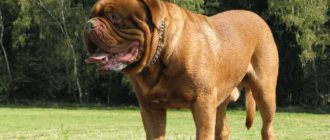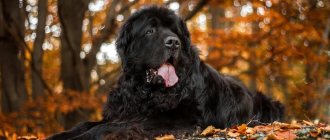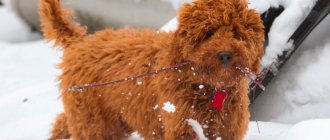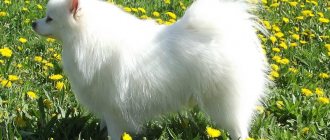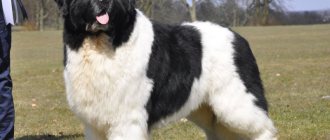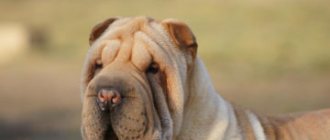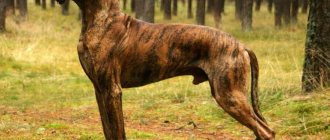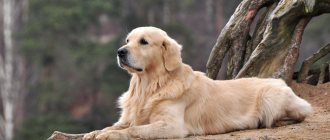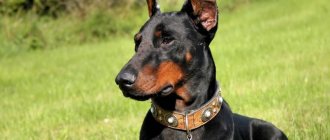The Newfoundland is a unique dog, which is also called a diver. Her impressive size and menacing appearance do not at all combine with her surprisingly good-natured character. These dogs have no aggression towards any living beings at all; they love to serve people and help those who are weaker. Because of this, the Newfoundland will not become a watchman or guard; it simply cannot bite a person. He is good-natured, sociable, obedient, affectionate and loyal. But before getting a dog of this breed, you need to study its description, pros and cons, and reviews from owners.
- Head
- Education and training
- Content Features
Breed traits
Breed traits (on a 5-point scale)
| Newfoundland | |||
| Activity | in the house | 1.5 | |
| on the street | 2.3 | ||
| Obedience | training | 3.6 | |
| strangers | 3.8 | ||
| Domination | in family | 1.5 | |
| over dogs | 1.8 | ||
| Defending your territory | from people | 1.1 | |
| from dogs | 1.4 | ||
| Sociability | in family | 4.2 | |
| with strangers | 3.8 | ||
| with dogs | 3.3 | ||
| Concentration | in family | 2.2 | |
| in front of strangers | 2.3 | ||
| with dogs | 2.5 | ||
| Aggressiveness | in family | 1.2 | |
| to strangers | 1.4 | ||
| to the dogs | 1.5 | ||
| to cats | 1.8 | ||
| Family behavior | calmness | 3.9 | |
| demand for affection | 3.5 | ||
| excitability | 2.2 | ||
| playfulness | 3.1 | ||
| excessive barking | 1.5 | ||
| behavioral breakdowns | 1.8 | ||
| Tolerance for children | up to 4 years | 4.5 | |
| over 4 years old | 4.6 | ||
| Institutional use | watchman | 2.2 | |
| bodyguard | 1.5 | ||
This breed is often compared to the following dog breeds: St. Bernard, Labrador Retriever, Caucasian Shepherd, Leonberger, Golden Retriever.
The photographs show what Newfoundlands look like:
Newfoundland dog
Newfoundland breed
Newfoundland dog face
Dog diver
Diver
Exercise stress
To maintain good physical shape, they need daily walks with moderate physical activity, which will help prevent the development of musculoskeletal diseases in dogs. The Newfie will be happy to go for a morning jog and join the company for an evening walk or hike in the forest. With age, dogs stop actively participating in children's games, quickly get tired and lose interest in them. Therefore, games should be varied and short-lived.
Since divers are massive dogs, it is best to take them on slow jogs or active walks in a cool breeze. Newfoundlands love to swim and are always ready for a dip. If you don’t want your pet to wet himself unexpectedly, be careful when you encounter any bodies of water on your walks. Dogs of this breed love
General characteristics of Newfoundland
The Newfoundland is a big, beautiful and fluffy dog. Many people know what he looks like. He has very fluffy thick fur, a large build and a large head that resembles a bear's. Features of appearance also include the presence of membranes between the fingers. This helps the dog to swim and dive well. Because of its love for water, in Russia this breed has another name - diver.
Newfoundlands were bred as working dogs. During selection, attention was paid to qualities that are useful to people. Now they are the best rescuers of drowning people, guides for the blind and disabled. Many Newfoundlands serve in the police, participate in expeditions and military operations. This dog is considered the best companion and pet for families with children. It is suitable for inexperienced dog owners, homebodies, and elderly people.
| Options | Characteristic |
| breed name | Newfoundland (Newfoundland), diver |
| country of origin | Canada |
| group of breeds according to the ICF classification | Pinschers and Schnauzers, Molosser section |
| application | rescuer, guide, companion, nanny |
| character traits | sociable, friendly, loyal, well-developed rescue instinct, love water |
| life expectancy | 9-11 years |
| height | males up to 71 cm, females up to 66 cm |
| weight | males 68 kg, females 54 kg |
| aggressiveness | completely devoid of aggression |
| activity | low, it is enough to walk twice a day for an hour |
| attitude towards a person | feel the need to help, love all people, are patient with children, cannot stand loneliness |
| intelligence | very smart, quick-witted, capable of independent decision-making |
| health | weak |
| difficulty of care | difficult, shedding a lot |
pros
The Newfoundland is a big, strong dog whose purpose in life is to serve man. His unique good-natured bear appearance immediately attracts attention. These dogs are popular all over the world due to the following advantages:
- very smart, capable of making independent decisions;
- easy to train, love to perform tricks and help people;
- have an innate desire to save those in trouble;
- are not afraid of water, swim well;
- devoted, faithful, love all family members, affectionate;
- sensitive, able to predict the owner’s wishes, feel his mood;
- they adore children, are patient and careful with them, will never abandon or offend them;
- get along with all pets, are not jealous and do not seek to dominate;
- strong, hardy, fearlessly rushing to protect the owner, not afraid of loud sounds;
- calm, do not need high physical activity;
- They don’t chew things, don’t rush around the house, don’t make noise.
Minuses
You might think that the Newfoundland is the ideal dog, the best companion for humans. But it is not suitable for everyone. In addition to the enormous size, which makes the dog uncomfortable in the apartment, there are other disadvantages of keeping it:
- very thick fur requires constant brushing, shedding profusely, which can be a problem for allergy sufferers;
- Newfies do not tolerate heat well, they often suffer from heatstroke;
- despite their impressive appearance, they do not have guard qualities;
- these dogs have poor health and a fragile skeleton;
- excessive salivation;
- touchy, cannot tolerate raising their voices;
- They become strongly attached to their owner and cannot stand loneliness.
The video complements the characteristics of dogs of this breed:
Video: Newfoundland. Pros and cons of the breed
Video: Newfoundland. Breed characteristics
Video: Newfoundland - friend, companion and rescuer
Nutrition
The Newfoundland is a dog that is not prone to allergies, so it can eat both natural food and dry factory-made food. It all depends on both the preferences of the animal and the owner. The ideal option is a coincidence of desires.
Moreover, if we are talking about factory products, it is worth keeping in mind: cheap food will ruin the dog’s health. Premium category food is recommended. They contain additional micro- and macroelements and vitamins.
Black and white Newfoundland
Natural feeding will require compliance with the regime, proportions, additional vitamin supplements, processing of raw foods, cooking cereals, variety, balance. The amount of protein should be two-thirds of the total nutrition.
These include lean varieties of lamb, beef, chicken and turkey meat, offal, vegetables, sometimes eggs and sea fish, vegetable oil and cereals such as buckwheat and rice. Newfoundland puppies eat up to six times a day, adults - twice a day. At any age, it is important to ensure constant access to drinking water.
History of the origin of the Newfoundland dog breed
This breed originated on the island of Newfoundland in Canada, which is why it is called that. The first mention of fluffy dogs that swim well dates back to the 18th century. They were described as smart and good-natured, with developed working qualities. These large dogs helped fishermen pull out nets, carry loads, and rescue drowning people.
Local residents selected individuals with endurance, loyalty, obedience, and withstanding harsh climatic conditions. The result was a completely non-aggressive dog with webbed paws and thick hair with water-repellent properties. She was devoted, willingly serving people. The unique feature of her sense of smell allowed her to find a person by smell in the water and pull him out without injuring her teeth.
There are several versions of what breeds were the ancestors of the Newfie. Many dog experts believe that they descended from Molossians and other mastiff-like large dogs brought to the island by the Vikings. They crossed with local sled breeds. There are different opinions that the ancestors of Newfoundlands were wolves, shepherd dogs, huskies, Tibetan mastiffs or Pyrenees mountain dogs. Another version is that the breed formed independently. For a long time, these dogs lived near the sea, so they acquired such features as webbed paws and water-repellent properties of the coat.
Newfoundlands took the best qualities from their ancestors. Already at the end of the 18th century, they attracted dog breeders with their friendliness and desire to help people. They began to be exported to England and were given the name “Newfoundland”. But it was only towards the end of the 19th century that the breed became popular. Clubs began to be created, and the first standard was developed. The breed has spread throughout the world.
These large dogs appeared in Russia at the beginning of the 20th century, but did not become popular. They began to be imported en masse after World War II. Then dog handlers tried to breed a new breed. Newfies were crossed with shepherd dogs and were called Moscow divers. But they turned out to be aggressive and were not suitable for guard duty.
The experiments were stopped, and in the 80s they began to import Newfoundlands from abroad. Now the breed is popular in Russia. It meets international standards. But these dogs are still called divers.
Old pictures show that Newfoundlands have always served man:
Old picture of the Newfoundland breed
Old picture of the diver breed
Old picture of the Newfoundland breed
Reviews
Let's look at the reviews about the Newfoundland dog. Let's find out what dog owners say about the breed. Each review about the Newfoundland breed is written by a person raising this animal, so there is no doubt about the reliability of the facts stated below.
Kirill. Stavropol.
Hello. My review of the Newfoundland is for those who love dogs and want a loyal friend. Newfoundland Alya lives at my home. So this is a smart dog. She will not bite either a child or an adult. Alya loves water, they are generally said to be good lifeguards. If you put sausage in front of her and you can’t tell, she won’t take it until you give her permission. We go swimming with her, she dives, the children especially have fun when they watch her dive. Alya is affectionate and, of course, with character. If you scold her, she goes away and hides and won’t come out until you call her. If you decide to, take it, a Newfoundland diver dog, it’s a good breed.
Squirrel. Saint Petersburg.
When I first saw the Newfoundland dog breed in person - a healthy black and white dog, I was scared. Imagine a healthy animal, like a tank, running towards me. But it turned out that this is a very affectionate dog and plays like that. The Newfoundland is a dog of rare kindness.
I can’t keep silent about an interesting fact - our whole team searched for negative reviews about Newfoundlands and never found a single one. Yes, people respond with slight grumbling regarding fur and drool, but in general the picture of reviews is friendly, which speaks only positively about the breed.
Appearance
The Newfoundland is a large dog with a powerful, athletic build. With its luxurious thick fur and head shape, it resembles a bear. Due to his colorful appearance, his images are often found on stamps and coins.
The height of dogs at the withers is on average 66-71 cm, in some individuals it reaches 80 cm. Weight is 54-68 kg, sometimes more. Despite such large size, the dog does not look heavy or clumsy. She is harmoniously built, her movements are well coordinated. The appearance features are determined by the 1996 standard, which is not very different from the first one adopted in the 19th century.
Photos of Newfoundlands:
Head
The skull is large, wide, convex, with a pronounced occipital protuberance. The stop is not sharp, but clearly noticeable. The muzzle is quite short, almost square in shape. The cheeks are soft, the corners of the mouth are clearly defined. The lips are fleshy, hang down, but do not reveal teeth. There are no folds on the muzzle.
The nose is large, wide, black or brown, depending on the color of the dog. The jaws are powerful, the teeth are large. The bite can be either straight or scissor.
The eyes are small, dark brown in color; in brown individuals they may be lighter. The eyelids should not droop. The eyes are set quite deep and slightly slanted. Because of this, the look seems sad. The ears are medium-sized, triangular, with rounded tips. Set closer to the back of the head, hanging down.
Torso
The physique is massive, muscular, strong bones. The body shape is square. In bitches it may be more elongated in length. The neck is muscular, without dewlap. The back is wide, straight, the croup is sloping. The chest is deep, voluminous, but not wide, the stomach is not tucked.
The tail is wide at the base, tapering towards the tip. It is strong and acts as a rudder in the water. When at rest, it is lowered, reaches the hock joints, and bends slightly. Never rolls over on its back.
Limbs
The forelimbs are straight and muscular. Remain parallel even when the dog moves. The shoulders are directed back, the elbows are close, the pasterns are slightly inclined. The hind legs are powerful, with wide, muscular thighs. The shins are strong, the knee joints are pronounced. Hocks parallel, short.
The paws are wide and rounded. The fingers are gathered into a ball, with membranes between them. The movements are light, sweeping, free. The dog is able to run a long distance and swims very well.
Coat and colors
Double wool, water-repellent. The dog's entire body is covered with long, thick, fairly stiff guard hairs. They are usually straight and smooth, but can be slightly wavy. The undercoat is double, very thick and soft. It is especially dense on the chest and rump. Thanks to these features of their coat, these dogs are not afraid of severe frosts and cold water, but do not tolerate heat well.
The hair on the tail is long, without undercoat, and the paws have feathers. On the head it is shorter, thinner and softer. There is no collar on the chest and neck that would prevent the dog from swimming. The soft, silky undercoat, which can be combed out, is recommended to be spun. This wool is good for knitting socks, mittens, sweaters, and anti-radiculitis belts. Things turn out warm and waterproof.
The most common color found in Newfoundlands is black. The color is rich, anthracite, uniform. Sometimes it fades in the sun, acquiring a brownish tint. The standard allows two more varieties of color. Brown color from milk chocolate to dark bronze. The color is uniform, sometimes small white spots on the chest, toes, and tail.
White Newfoundlands with spots are rare. This black and white color is called Landseer. The dog's head and ears are black, with a white stripe on the forehead, large black spots at the base of the tail, and a saddle on the back. Silver-gray Newfoundlands are even rarer. In America they are classified as a separate breed. But in Russia this color is not recognized and gray individuals are not allowed to exhibit.
The pictures complement the description of the Newfoundland breed:
Health and life expectancy
Like any large dog, Newfoundlands are susceptible to joint dysplasia : elbow and hip. In addition, there are some problems of the cardiovascular system (arrhythmia, aortic stenosis, cardiomyopathy and other diseases), as well as possible entropion of the eyelids, cataracts, problems with the thyroid gland and intestinal volvulus.
Also, some people may find drooling , which Newfoundlands can drool very profusely, unpleasant.
Well, the worst thing is the short life expectancy of Newfies, they live only about 9-10 years . The only good thing is that these years you will be happy every day, since Newfoundlands are truly unique.
Newfoundland character
These dogs are called the kindest and best family companions. They are devoid of aggression and are not capable of biting a person under any circumstances. If the owner is in danger, they fearlessly rush at the offender, but the most they can do is knock them down and bark. Therefore, the Newfoundland makes a bad watchman or guard.
But they perform the role of a nanny perfectly. These dogs love children, behave on equal terms with teenagers, and participate in all games. They treat the kids patronizingly, patiently endure anything from them, and protect them. Parents should not be afraid to leave their child with this nanny. Newf will never offend him, will make sure he doesn't get into trouble, and will call adults if necessary. This dog also treats all pets kindly and tries to make friends with dogs and cats.
Newfoundlands become very attached to their owner and family members, cannot tolerate changes of owners, and are very bored. Although they are friendly with all people, they strive to help and protect, and show heroism in dangerous situations. Their purpose since ancient times has been to serve man. Therefore, they are happy to do any work: look after children, carry bags, accompany their owner on a walk. These dogs serve in the police, rescue units, accompany the blind, and transport cargo.
These pets are loyal and sociable. They love to accompany their owner everywhere, but are never annoying. They don’t pester or bark for no reason. They are able to predict the mood and desires of the owner. They feel pain, begin to lick the sore spot or lie on it. This can help with joint diseases. Newfoundland creates an atmosphere of kindness, calmness and comfort in the home.
It is no coincidence that this dog is called a diver. Newfoundlands love water and are ready to swim all day long. They are excellent dives, able to smell any smell in the depths, and find a drowning person.
Most representatives of the Newfoundland breed have the following character traits:
- lack of hunting instincts;
- lack of aggression;
- ability to make independent decisions;
- friendliness;
- devotion;
- sociability;
- patience;
- calm;
- curiosity;
- fearlessness;
- tact;
- good nature;
- intelligence;
- politeness;
- touchiness.
Interesting pictures complement the description of the behavioral characteristics of these dogs:
Education and training
The Newfoundland is a very smart and quick-witted dog with a good memory. But it is not suitable for those owners who expect unquestioning obedience. This dog will not carry out commands that it considers meaningless. Although he is not stubborn, not capricious, flexible and does not seek to dominate. And in a dangerous situation, he quickly makes a decision and rushes to the person’s aid.
Owners often say that adult Newfoundlands are as smart as humans. They have their own opinions and know how to think. They do not need to be trained specifically for rescue work; they rush to help without the owner’s command.
Newfoundlands are easy to train, they pick things up on the fly and love to learn. They quickly respond to commands and requests spoken in a calm voice. It must be borne in mind that these dogs are touchy. They do not tolerate rudeness or shouting. They may even be offended by a command given in a loud, stern voice. These dogs are sensitive to voice intonations, so there is no need to shout at them. And hitting or roughly tugging on the leash is unacceptable.
Even a Newfoundland puppy will try to please its owner. But you shouldn’t indulge your child’s whims and spoil him. Education must begin immediately; all family members must adhere to the same rules. The puppy needs to be accustomed to the toilet, place, and its name. It is easy to socialize him, since Newfies are not afraid of cars, loud sounds, or strangers.
The dog learns basic commands quickly, loves to learn new things and perform tricks. It is better to conduct training in a playful way, to diversify it. It is important to understand that a dog is constantly learning, so it needs to be trained not only during classes.
Training
The character of the Newfoundland is calm and obedient; by the age of 2-3 months, the baby can follow a couple of simple commands.
Considering that this breed loves water, training near a pond is mandatory. Just don’t force him there, you need to get him interested. When a child finds himself in the water element, his instinct to save is activated, no matter whether the person is drowning or standing in the water. The owner comes across first.
The dog always tries to please; in case of failure, you need to be patient, not punish your pet, just tell him about it.
You need to start with the simplest:
- Walk with or without a leash nearby;
- Sit;
- Lie;
- Give me a paw.
Caring for Newfoundland dogs
Caring for Newfoundlands is not easy. Thick fur sheds heavily and quickly becomes tangled. It needs to be brushed 3-4 times a week, and daily during shedding. You will need a stiff bristle brush, a long-toothed comb, and a slicker brush. In the summer, you can take your dog to a groomer for a short haircut.
The diver does not need to bathe frequently. Wool has the ability to repel not only moisture, but also dirt. Using shampoo when washing violates its protective properties. In the warm season, swimming in natural bodies of water is sufficient. After a walk, you need to wash your paws and wipe your face after eating. To protect the coat in dirty weather, it is better to put a blanket or raincoat on your dog.
You should regularly check your eyes and ears and wipe them with a napkin. If there is discharge, contact your veterinarian, who will recommend drops. You need to trim your nails once a month and brush your teeth every week.
Content Features
Despite the enormous size of the diver, you can keep it in an apartment, the main thing is that it is not small. But he feels best in a private house with a plot. Just don't put this dog on a chain. She still won’t make a watchdog, but this can break her psyche. After all, these dogs cannot live without human communication.
The Newfoundland needs space and freedom of movement. You need to make a comfortable place for him to sleep in the house. Preferably a spacious mattress with an orthopedic base. The cover should be easy to remove and wash. You also need to allocate a separate bowl for food and water, which is best placed on a special stand.
Newfoundlands are very calm and lazy dogs. They love to lie down, so it is necessary to walk them at least 2 times a day for an hour. Otherwise, the dog will gain excess weight. At least once a week you need to take your pet out into nature, give him the opportunity to run, and even better, swim.
The video will help you understand how to properly care for these dogs:
Video: 5 features of caring for a Newfoundland
Video: Grooming a large dog
Video: Walk by the river with Era. The spring weather is pleasant. We run, play, swim.
Health
The health of these dogs is rather poor and their life expectancy is short. On average, Newfies live 10 years, and if you make mistakes in keeping and feeding, then even less.
These dogs are prone to obesity and heart disease. Due to their massive build, they often develop arthritis and joint dysplasia. Their bones are not very strong, so injuries occur. In summer, overheating and heat stroke are possible. Newfies are also prone to eye diseases and ectropion.
Nutrition
The diet of this large dog must be balanced and contain enough protein. But Newfies are prone to obesity, so they should not be overfed. The easiest way to dose dry food is that an adult dog needs 500 g per day. They should be super-premium or holistic class, designed for large breeds.
With a natural diet, more than 50% of the diet should be lean meat, this is approximately 1-1.5 kg per day. Pork and fatty poultry are not recommended. You also need to give porridge - buckwheat, rolled oats or rice, fresh and boiled vegetables, except potatoes and legumes. Greens, fermented milk products, and sea fish are healthy. Sweets, smoked foods, pickles, canned food, sausages, fatty and fried foods are prohibited. Additionally, you need to give multivitamin complexes.
Possible diseases
Newfoundlands have two breed-specific conditions: hip dysplasia and heart defects. As a rule, heart disease in dogs is congenital. Dysplasia can affect one joint or both, have a mild form or complete dislocation of the femoral head. The disease requires veterinary intervention.
In addition, joint diseases include panitis, an inflammation of the long bones. It usually affects young individuals up to one year old. Unofficially, the disease is referred to as intermittent claudication, which goes away on its own over time. In addition, eye diseases are not uncommon, most often these are entropion of the eyelids, internal and external.
They injure the cornea, causing the eye to become inflamed. In this case, surgery cannot be avoided. Another ophthalmic disease is third eyelid prolapse, where red tissue grows in the inner corner of the eye.
Most often it affects puppies. In this case, you need to completely remove the lacrimal gland. After the operation the Newfoundland , which belongs to the show class, will no longer be allowed to participate in exhibitions.
This large breed often suffers from bloating. As a preventive measure, a diet is suitable, ignoring legumes and any food that can cause fermentation. It is important not to overfeed the dog. Bloating is a companion to volvulus, a fatal disease. To avoid illness, the dog should not be chased after eating; it is better to let it rest.
How to buy a Newfoundland puppy
It is better to buy a Newfoundland from a special nursery. Then there will be a guarantee that the puppy is purebred, without defects and hereditary diseases. The price of such a dog in Moscow is 30-40 thousand rubles. In the regions the cost is less - 20-30 thousand. Offspring from champion dogs will be more expensive - from 50 thousand rubles. You can buy such a dog from someone else or on the market for 5-10 thousand rubles.
Newfoundland puppies for sale at 1.5-2 months. At this age they weigh 7-12 kg. When choosing, you need to pay attention to the breed characteristics and behavior of the animal. The puppy should not be cowardly or aggressive. A healthy baby is cheerful, curious, and playful. He has shiny fur, eyes and ears without discharge. It is advisable to check all the documents, study the mother’s behavior, and the conditions in which the animals are kept.
The photo shows what the puppies look like:
More interesting photos characterizing dogs of this breed:
To decide whether to get a Newfoundland, you need to watch another video:
Video: Newfoundland - All about the breed. Interesting facts about Newfoundland
Video: Newfoundland. Breed characteristics
Video: Newfoundled. Breed characteristics, care
The Newfoundland is a kind dog, suitable even for inexperienced owners. She doesn’t require a lot of walks, she is easy to train, very smart and loyal. But she needs emotional contact with her owner; she gets very bored alone. Therefore, it is an ideal friend and companion for large families, for people working from home, and retirees. This breed is not suitable for those who are rarely at home and cannot pay attention to their pet.
Price
The cost of puppies of this breed varies depending on their purebred, availability of all necessary documents and the opportunity to participate in future exhibitions (or raise breeding offspring).
Depending on the above reasons, the price of puppies ranges from $350 to $2000.
The Newfoundland is a dog that can be an excellent watchdog, rescuer, nanny and companion. If you follow the rules for the care, training and feeding of these animals, one of the best and smartest dogs in the world will live in your home.
